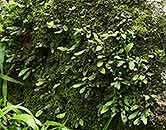Elaphoglossum spathulatum (Bory) T. Moore var. spathulatum
Synonyms |
Acrostichum spathulatum Bory |
|---|---|
Common name |
|
Description |
Rhizome short creeping to suberect, c. 3 mm in diameter; rhizome scales pale brown, narrowly lanceolate, margins entire, apex forming a long drawn out point, up to 4 mm long; phyllopodia absent. Fronds simple, clustered, firmly herbaceous, erect, strongly dimorphous with the fertile fronds longer than the sterile fronds. Sterile fronds: stipe 0.4-1.8 cm long, slender, straw-coloured with orange-tan scales 1-1.5 mm long; lamina 1-2.6 × 0.35-1 cm, narrowly oblanceolate to spathulate, apex rounded, base wedge-shaped and long decurrent, scales of the type of the stipe on both surfaces, 1.5-2.5 mm long; veins obscure, free, simple or rarely once-forked, c. 1 mm apart, at 40-50° angle to costa; hydathodes present but inconspicuous. Fertile frond taller than sterile frond: stipe 2.5-4.6 cm, thin, densely set with almost hair-like, entire, pale brown scales up to 2 mm long; lamina 0.8-1.2 × 0.6-0.85 cm, broadly elliptic to circular, base hardly decurrent, upper surface scaly as the sterile lamina, lower surface completely covered by sporangia, the two halves of the lamina often folded tightly along the midrib over the sporangia and sometimes quite difficult to unfold, intersporangial scales absent. |
Notes | The small size and the distinctive scales on the lamina separate this species from others. E. spathulatum var. uluguruense has a sterile frond lenght > 4 cm and a blade width:lenght ratio 1:>4. |
Derivation | spathulatum: spoonshaped, referring to the shape of the lamina. |
Habitat | Lithophytic on moss covered rocks along streams in deep shade of moist evergreen forest or sometimes terrestrial on mossy earth banks near streams. |
Distribution worldwide | Africa, Madagascar, Mauritius, Réunion, Sri Lanka. |
Distribution in Africa |
Congo, Kenya, Malawi, Mozambique, South Africa, Tanzania , Zambia, Zimbabwe. |
Growth form |
Lithophytic, terrestrial. |
Literature |
|



